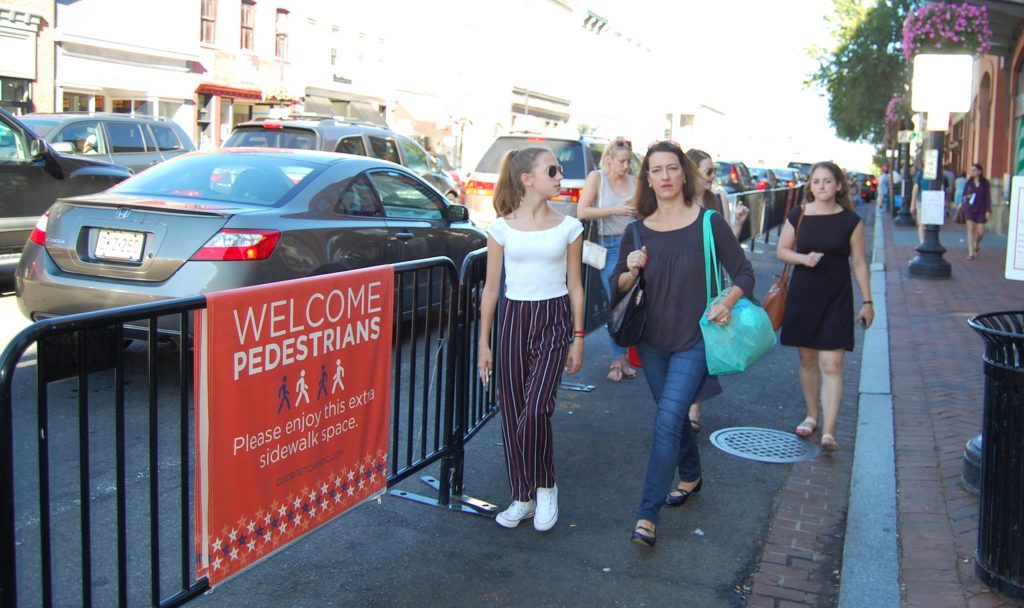Town Topics: Oct. 11, 2017
By • October 11, 2017 0 496

By Peggy Sands and Robert Devaney
M St. Sidewalk Expansion Extended
Every weekend since early summer, crews from the Georgetown Business Improvement District have installed street barriers and some planters to expand the sidewalks of M Street between Potomac Street and Wisconsin Avenue six feet out from the curb on both sides. All the parking spaces along the two blocks are inoperative for the entire weekend.
“Welcome Pedestrians!” read signs attached every few feet along the barriers. “Please enjoy this extra sidewalk space.”
“It’s an experiment, a pilot program,” said Jamie Scott, the BID’s economic development manager. “We’re not sure yet of the impact. We’ll be doing a comprehensive survey soon to determine it. But we decided to continue the wider sidewalks through the holiday shopping season and the end of December.”
Reactions to the expansion have been mixed, The Georgetowner found during an informal preliminary survey on Saturday, Sept. 23. Some shop managers and shoppers said they liked the feeling of not been packed in, as in New York City. Some said it had increased drop-in business, notably from people with strollers. Others resented the loss of parking in front of their stores and restaurants, especially for regular customers, and the increased pressure for parking in the nearby residential streets.
“We haven’t been able to beautify it with planters and furniture to make it more attractive, as we had hoped,” admitted Scott. The biggest challenge is logistics, especially where to store all the barriers and future enhancements in a flat area easily accessible to M Street.
Georgetown Main Street Gears Up
A $175,000 Main Street grant for Georgetown from the District’s Department of Small and Local Business Development was approved Oct. 2 by Mayor Muriel Bowser. The grant will fund technical assistance for commercial revitalization initiatives along Wisconsin Avenue from Whitehaven Parkway (about one block north of Safeway) to the Georgetown waterfront.
“We are very concerned about vacant storefronts all along Wisconsin currently. There will be more,” said Sonya Bernhardt, president of the Georgetown Business Association, the grantee. “One of our first tasks will be to talk to all the businesses along Georgetown’s designated Main Street to determine those that are doing well or struggling and where there are vacancies.”
One goal is to develop an interactive website to help business owners who lease their spaces, immediately identifying where new space may be available and tracking price fluctuations and how long it took to fill vacancies in the past, according to Bernhardt, also publisher of The Georgetowner. “This should help business owners to negotiate better deals.
“We understand that there are some stores along Wisconsin Avenue that are unattractive to the changing Georgetown demographic,” said Bernhardt. “Now that the liquor license moratorium has been lifted, Georgetown’s Main Street is open to creating more attractive businesses. We’ll also provide help to address recurring problems along the Main Street, especially concerning the business use of outdoor spaces — roof and garden terraces, for example, that come as part of the lease.”
The next steps facing GBA are to assemble a board of directors for the Main Street and to hire an executive director, who will be expected to help develop and guide the vision of the project and fundraise for specific initiatives. A two-part application process for the full- time position, which pays $55,000 to $60,000 annually, has been developed by Martin Smith, executive director of the Barracks Row Main Street, who advised GBA on the Georgetown Main Street proposal.
After submitting a resume with relevant experience, each applicant will be sent a “skills exercise.” Applicants will be given two hours to answer six “incredibly varied” situational questions in order for reviewers to “get a general feel for how your process works … on new and unfamiliar projects,” according to the letter.
GBA’s board and advisors will decide which candidates to interview, with Bernhardt signing off on the final choice.
The DC Main Streets grant award can be renewed annually as long as the grantee continues to meet the standards for accreditation by the National Main Street Center. The FY 2018 grant performance period is Oct. 1, 2017, through Sept. 30, 2018. The association is asking Georgetown business owners to send letters of support to info@georgetownmainstreet.com.
Mayor Bowser plans to attend the grand opening of the Georgetown Main Street on Oct. 25 at 6:30 p.m. at the Phoenix, 1514 Wisconsin Ave. NW.
Key Bridge Arch Lighting: Say Yes to Color?
A plan to light the arches of Key Bridge has caused some contention between those who want the scheme to be all-white-lights-all-the-time and those who want colored lights to be allowed on special occasions. The debate at the Georgetown Public Library on Sept. 27 and at the Oct. 2 meeting of the Georgetown-Burleith Advisory Neighborhood Commission was not about if there should be decorative lights highlighting the bridge’s unique architectural features, but rather about what color they should be and when they should be turned on.
But it is even more complicated than that — as only a government project can be.
The Francis Scott Key Bridge Architectural Lighting Project, now in the review stage, has been developed by the District Department of Transportation and the Federal Highway Administration.
Given the bridge’s historic designation and the fact that it stands on National Park Service land, a number of factors had to be considered to get to this stage. The plans need to comply with the National Historic Preservation Act and other federal laws, regulations and guidelines and take into account potential impacts on air traffic (since the northern approach pattern to Ronald Reagan Washington National Airport passes directly over the bridge) and water traffic (so as not to blind boaters from clearly seeing the navigational lights at the base of the piers). Consideration also has to be given to other historic properties “within the viewshed,” that is, views to and from Key Bridge from vantage points along both sides of the Potomac River, as well as upstream and downstream of the bridge.
In addition, over a dozen agencies are in the mix, including the Federal Aviation Administration, the Federal Highway Administration, the Army Corps of Engineers, the Coast Guard, the Commission of Fine Arts, the National Capital Planning Commission, D.C.’s State Historic Preservation Office, the Virginia Department of Historic Resources and Arlington County’s Historical Affairs and Landmark Review Board, as well as various community organizations.
Minimal interference to vehicle and bicycle traffic on the surface, and to boat traffic below, is expected, according to DDOT. Lighting fixtures will be attached on the underside of the bridge and the majority of construction activity will occur underneath the bridge, as with the reconstruction project now underway. Any work affecting traffic will take place only during midday and overnight hours. Key Bridge carries six lanes of U.S. Route 29 two-way traffic between Georgetown in Washington, D.C., and Rosslyn in Arlington County, Virginia.
The discussions in Georgetown were led by Joe Sternlieb, president and CEO of the Georgetown Business Improvement District. The Citizens Association of Georgetown spoke in favor of white lights only.
LED Hues Cause Controversy
The color of lights is controversial not only on Key Bridge, but also on the streets of Georgetown. A streetlight modernization project aims to transform all of D.C.’s some 75,000 streetlights by installing brighter, energy-saving LED bulbs.
The issue has to do with the LED streetlight bulb’s Kelvin rating, which measures color temperature. The lower the Kelvin rating, the warmer the yellow hue of the light; the higher the rating, the more harsh, cold and bright the blue-white light.
Currently, D.C.’s streetlights range from 1900 to 2100 Kelvin. Many activists in D.C. favor a 2700 K standard for the LED lights. But the city’s current standard for LED bulbs is 3000 to 4000 K.
Some 4200 streetlights have already been replaced throughout the District. A few are in Georgetown and a couple of those are in front of ANC Chairman Joe Gibbons’s home. While he accepts that some streets may benefit from brighter lights with higher ratings, Gibbons personally favors the 2700 K standard. And he is concerned that decisions are being made in the city without consulting neighborhood and community residents.
Georgetown-Burleith Advisory Neighborhood Commissioners voted unanimously at their Oct. 2 meeting to ask city officials to consult the community when determining which bulbs are appropriate for which streets. “That’s why we’re here,” Gibbons reiterated. “To give advice. So far the city hasn’t asked us.”
Don’t Even Think About It
We’ve probably all seen it — if we haven’t done it ourselves. Young people do it, sometimes business people do it. Certainly little old ladies and gentlemen do it. They live near a public garbage container on a street, in a park, perhaps near a restaurant. And to cut a bit off the monthly expenses or for some reason of convenience, they carry out their relatively small sack of personal garbage and drop it surreptitiously in the public bin.
Sometimes, the personal bag is not so small.
“I’ve seen huge personal bags of garbage spilling out of public receptacles,” Inspector Sonya Chance of the Department of Public Works reported at the Oct. 2 meeting of the Georgetown-Burleith Advisory Neighborhood Commission.
Well, be warned! Don’t even think about it. DPW is on to it and you will eventually be caught. “I and my colleagues have gone through bags of personal refuse,” Chance
related. “We have found mail, envelopes with names and addresses. We have issued fines — up to $75 an offense.”
Inspector Chance also shared other trash-disposal tips to avoid a fine, including putting out trash no earlier than 6:30 p.m. the day before collection in secured containers (not cardboard or plastic bags) with tight lids and taking them back in no later than 8:30 p.m. on collection day. She also warned attendees to keep the public space near their properties clean, including sidewalks, alleys, tree boxes, storm drains and overhanging tree limbs.

Ellington School CEO Tia Powell Harris, co-founder Peggy Cooper Cafritz, ninth grader Makael Exum, Dave Chappelle and Mayor Muriel Bowser pose with the auditorium crowd. Photo by Robert Devaney.
Chappelle Gives Emmy to Ellington School
On Sept. 29, Dave Chappelle returned to his alma mater, the Duke Ellington School of the Arts on 35th Street, to be given the key to the city of Washington, D.C., by Mayor Muriel Bowser, who called it a rare honor. In turn, the comedian, who earned an Emmy the week before, bought the statuette onstage and donated it to the school and students.
Tia Powell Harris, CEO of the Duke Ellington School, introduced Bowser, who spoke of the 1991 graduate as a fervent defender of the disenfranchised, “doing it the Dave Chappelle way” and speaking up for Washington, D.C., public schools — as he did during the Sept. 17 Emmy Awards show.
Accepting the key to the city, Chappelle spoke to the packed auditorium of students, telling them not to take things for granted. He said of the school’s reconstruction and expansion: “$170 million is a lot to spend on your future.” He then thanked Ellington cofounder Peggy Cooper Cafritz and continued: “Success is your choice. Your high school friends will be friends for life … I wanted to be a comedian. So I knew I needed to learn acting. I used to mop the stage.”

On Sept. 30, about 30 neighbors gathered as a part of the Montrose Park Fall Cleanup Day. Led by board members David Dunleavy, Micki Leder and Georgina Owen, the group took rakes, bags and elbow grease to the R Street park. Shown above: Avery Miller, Advisory Neighborhood Commissioner Monica Roache’ and David Dunleavy. Check Facebook for more information — www.facebook.com/MontroseParkDC.

